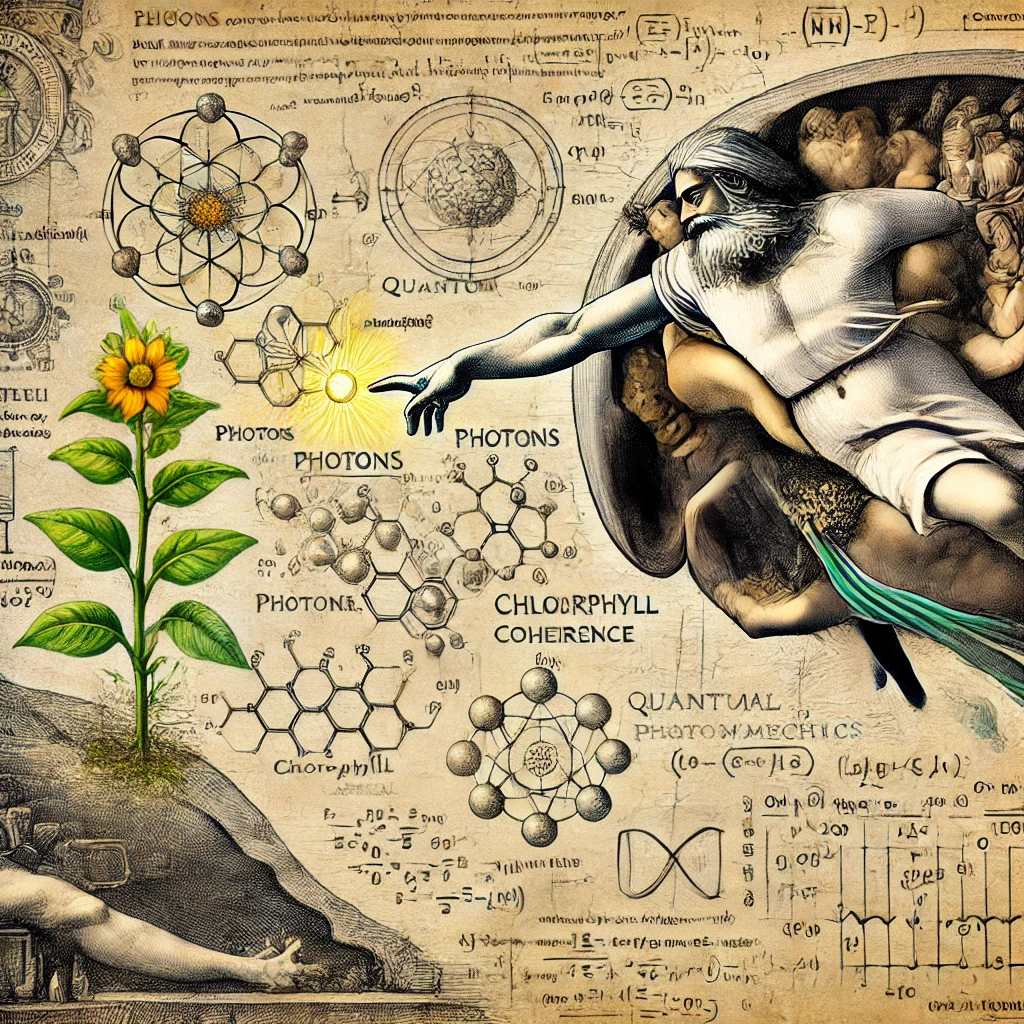
- Published on
- Authors

- Name
- ric de yuga 😄
🌿🔬 Photosynthesis: Nature's Quantum Alchemy 🔬🌿
Photosynthesis, the process by which plants convert light into chemical energy, has long been understood as a cornerstone of life on Earth. However, recent insights from quantum biology have revealed a deeper, more magical aspect of this fundamental process. In this article, well explore photosynthesis from both classical and quantum perspectives, uncovering the extraordinary way plants transform energy into mass.
🌱 The Classical View: Photosynthesis 101 🌱
At its core, photosynthesis is a complex series of chemical reactions that can be summarized by the equation:
6CO₂ + 6H₂O + light energy → C₆H₁₂O₆ + 6O₂
This equation represents the conversion of carbon dioxide and water into glucose and oxygen using light energy. The process occurs in two main stages:
- Light-dependent reactions
- Light-independent reactions (Calvin cycle)
During the light-dependent reactions, plants absorb photons through pigments like chlorophyll. This energy is used to split water molecules, producing oxygen and high-energy electrons. These electrons then drive the production of ATP and NADPH, which power the Calvin cycle.
🔮 The Quantum Perspective: Collapsing Wave Functions 🔮
While the classical view explains the overall process, it doesn't capture the quantum magic happening at the molecular level. Here's where quantum mechanics enters the picture:
- Wave-Particle Duality of Photons: Photons, the particles of light, exhibit both wave and particle properties. Their behavior is described by the wave function ψ(x,t), which evolves according to the Schrödinger equation:
iℏ ∂ψ/∂t = Ĥψ
Where ℏ is the reduced Planck constant and Ĥ is the Hamiltonian operator.
- Quantum Superposition: Before interacting with the plant, photons exist in a superposition of states, essentially being in multiple places simultaneously. This superposition is represented by a linear combination of possible states:
|ψ⟩ = c₁|ψ₁⟩ + c₂|ψ₂⟩ + ... + cₙ|ψₙ⟩
- Wavefunction Collapse: When a photon interacts with a plant's light-harvesting complex, its wavefunction collapses. This process is described by the measurement postulate of quantum mechanics:
P(a) = ⟨ψ|P_a|ψ⟩
Where P(a) is the probability of measuring outcome a, and P_a is the projection operator for that outcome.
- Quantum Coherence: Recent studies suggest that plants maintain quantum coherence during energy transfer, allowing for highly efficient energy propagation through the photosynthetic complex. This coherence can be described by the density matrix ρ:
ρ = |ψ⟩⟨ψ|
- Energy to Mass Conversion: The conversion of light energy to plant mass illustrates Einstein's famous equation:
E = mc²
Where the energy (E) from photons is converted into the mass (m) of glucose and plant tissue.
🌟 The Quantum-Classical Bridge 🌟
The quantum perspective reveals that plants are, in essence, quantum machines. They've evolved to harness quantum effects for maximum efficiency in energy capture and conversion. Here's how the quantum and classical views merge:
Photon Absorption: When a photon's wavefunction collapses upon interaction with a chlorophyll molecule, its energy is transferred to an electron, exciting it to a higher energy state.
Electron Transport: The excited electron moves through the electron transport chain, maintaining quantum coherence for optimal energy transfer efficiency.
ATP Synthesis: The energy from the electron transport chain drives ATP synthesis, converting light energy into chemical energy.
Carbon Fixation: In the Calvin cycle, the energy stored in ATP and NADPH is used to fix carbon from CO₂ into glucose, effectively converting energy into mass.
🔬 Implications and Future Research 🔬
Understanding the quantum aspects of photosynthesis has profound implications:
Artificial Photosynthesis: Mimicking these quantum processes could lead to highly efficient solar energy conversion technologies.
Crop Optimization: Enhancing quantum coherence in plants could potentially improve crop yields and resilience.
Quantum Biology: Photosynthesis serves as a model for studying quantum effects in other biological processes.
As we continue to unravel the quantum mysteries of photosynthesis, we gain a deeper appreciation for the incredible complexity and efficiency of nature's designs. Plants, it seems, are not just passive green organisms but sophisticated quantum machines, performing alchemy at the molecular level by turning light into life itself.
In the words of physicist Richard Feynman, "Nature isn't classical, dammit, and if you want to make a simulation of nature, you'd better make it quantum mechanical." Photosynthesis stands as a testament to this profound truth, reminding us that at the most fundamental level, life itself is a quantum phenomenon.
